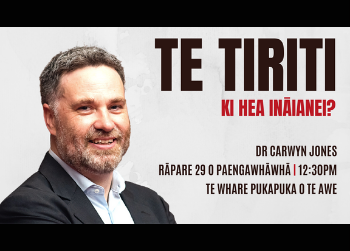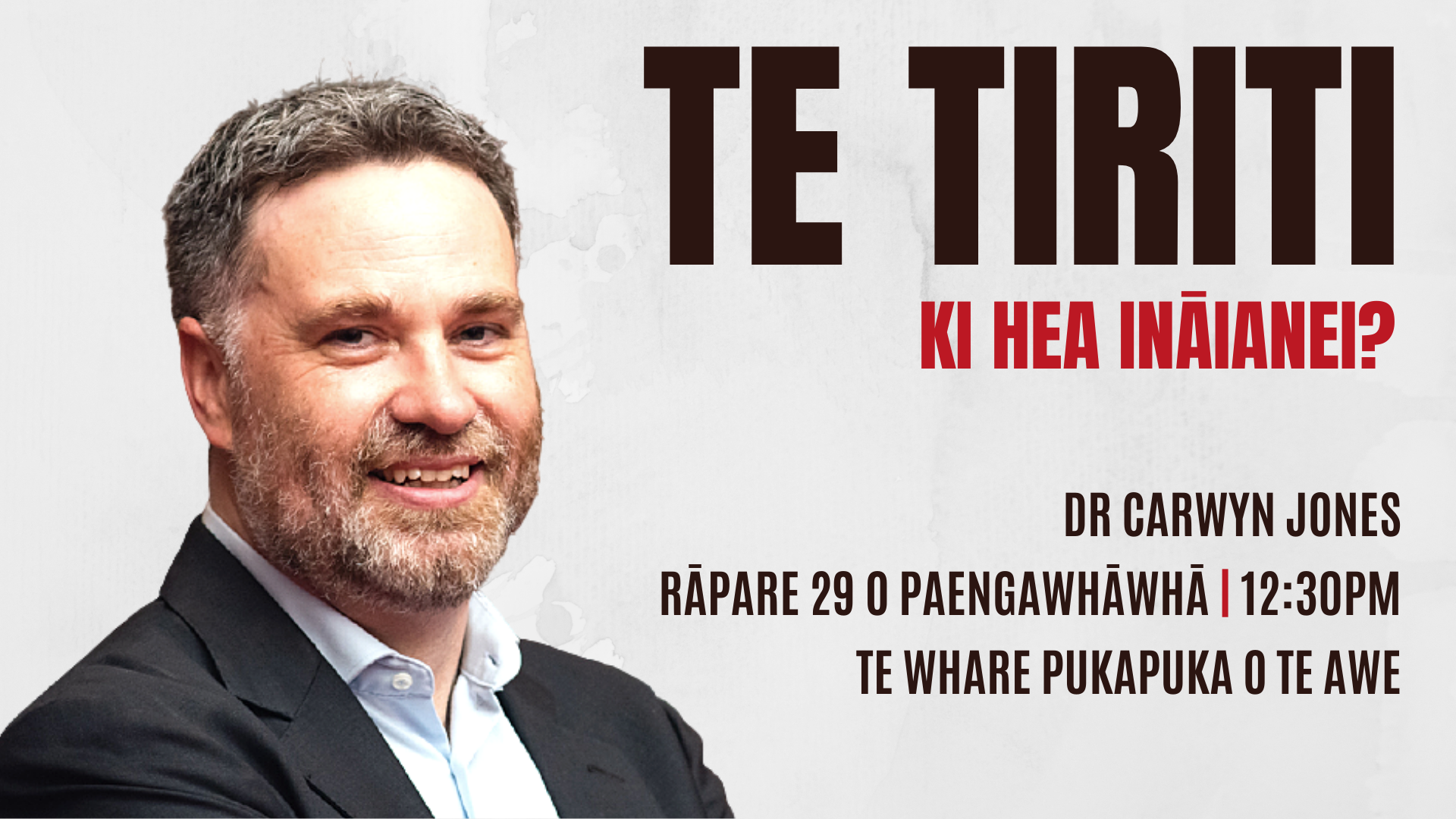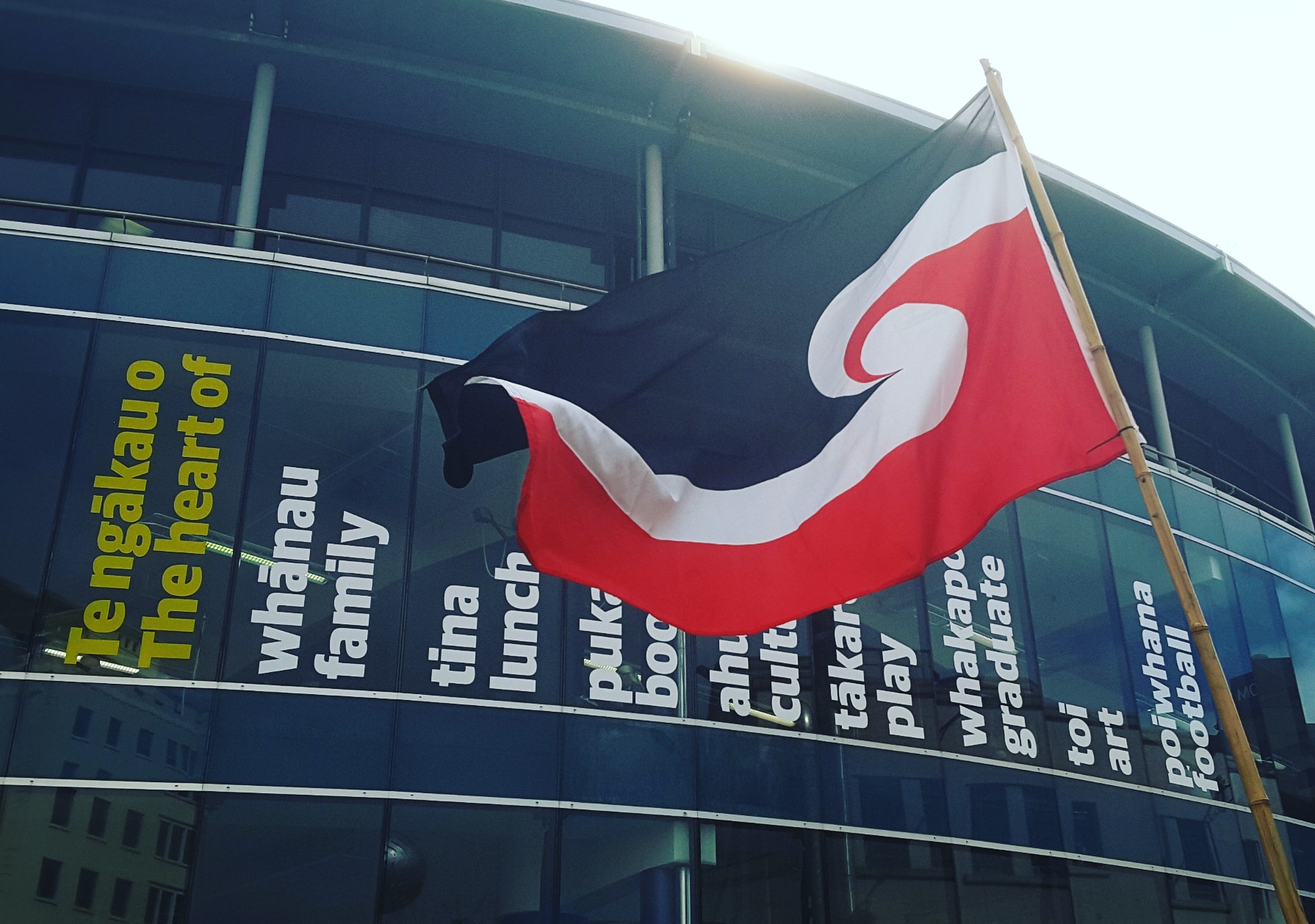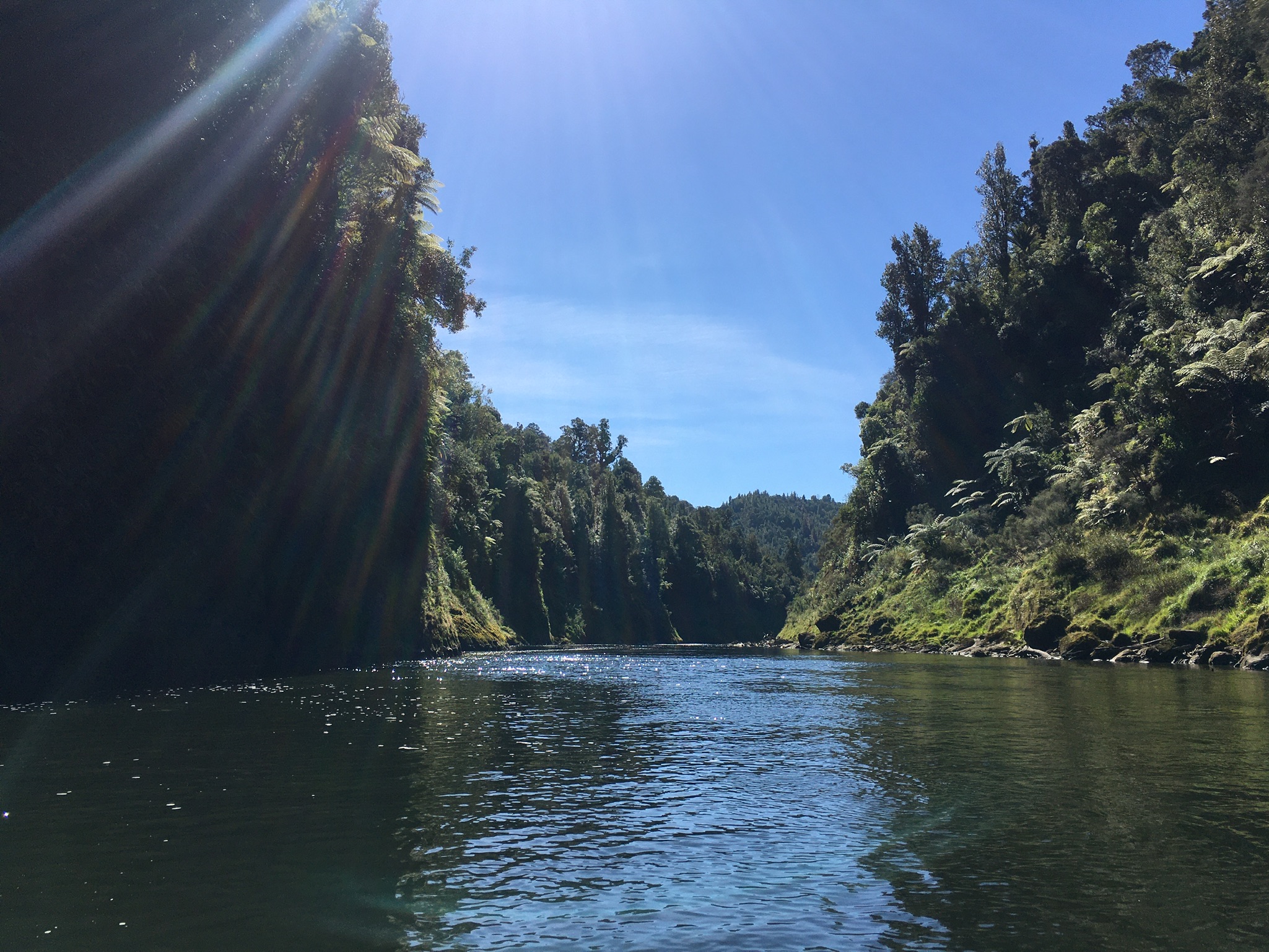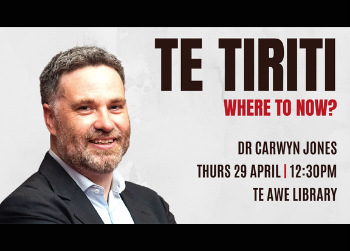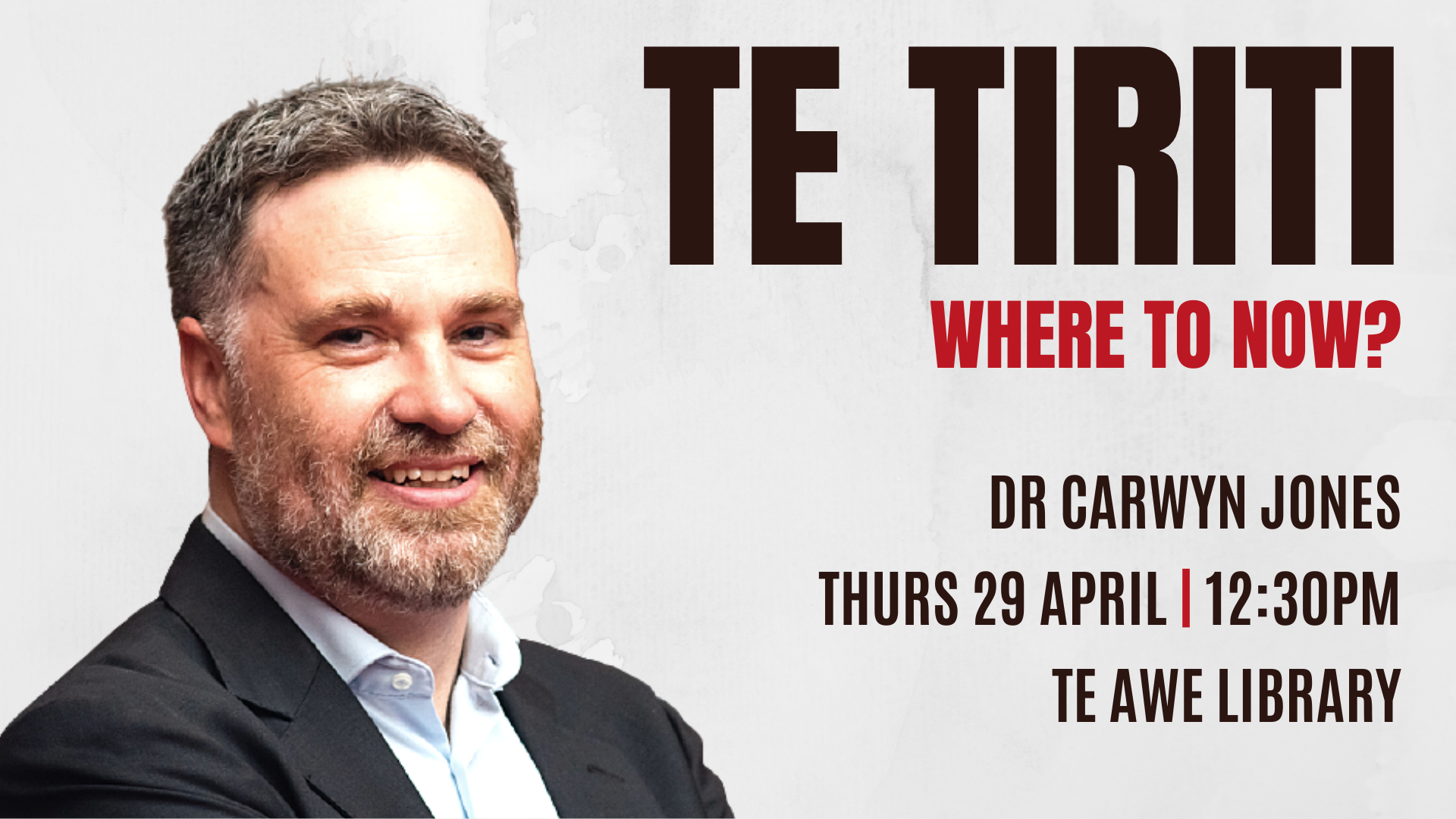He aha? Te Tiriti: ki hea ināianei?
Āhea? Rāpare 29 o Paengawhāwhā, 12:30-1:20pm
Ki hea? Te Whare Pukapuka o Te Awe (29B Tiriti o Brandon)
I runga anō i ngā tohutohu a Māmari Stephens i roto i tana tuhinga “He rangi tā Matawhāiti, he rangi tā Matawhānui”, kāore e tawhiti atu te whakanuitanga 200 tau o waitohutanga o Te Tiriti o Waitangi. Engari ka pēhea ianei te āhua o Aotearoa hei ngā 20 tau e tū mai nei? Ā, ka whakawā pēhea nei ngā tumu kōrero i te tau 2040 i ngā whanaketanga o ngā tekau tau ruarua ka hipa?
Ko tētahi tangata e taea ana pea e ia te whakautu i ēnei pātai ko Tākuta Carwyn Jones (Ngāti Kahungunu). He Ahorangi Tāpiri a Tākuta Jones i Te Kauhanganui Tātai Ture i Te Whare Wānanga o Te Herenga Waka, ā, ko ia hoki te kaituhi o New Treaty, New Tradition – Reconciling New Zealand and Māori Law and co-editor of Indigenous Peoples and the State: International Perspectives on the Treaty of Watangi. Ko ia hoki te perēhitini-ngātahi o Te Hunga Rōia Māori o Aotearoa, me te ētita-ngātahi o te Māori Law Review me AlterNative – an International Journal of Indigenous Peoples.
E whai wāhi ana hoki a Tākuta Jones ki tētahi atu kaupapa whakahirahira. E rua marama ki muri ka hono atu ia ki te ohu Adaptive Governance me te Policy i te BioHeritage Challenge, Ngā Koiora Tuku Iho, hei kaihautū-ngātahi me Tākuta Maria Bargh. He tūranga whakahirahira tēnei: ki te whakatau me pēhea e taea ai e ngā panonitanga ki te kāwanatanga me te ture i Aotearoa te āwhina ki te whakaora i te taiao o te motu – i mua o te hokinga kore ki muri.
Ki te rapu i ētahi atu kōrero, pānuitia tā mātou uiui ki a Tākuta Carwyn Jones i raro!
E kōrero ana te pae tukutuku a te Adaptive Governance me te Policy (AGP) mō tētahi mataaho āheinga e whakaratoa ana e te whanaketanga o tētahi Rautaki Koiora ā-motu, tae atu hoki ki te WAI 262. Ka taea e koe te whakamārama i te hiranga nui o WAI 262 me te Rautaki Koiora?
E whakarato ana te Rautaki Koiora i tētahi anga whakahaere matua mō te whanake i ngā mahere koiora ā-takiwā, ā-rohe hoki puta noa i ngā tau 30 e tū mai nei i Aotearoa. E whakarato ana hoki i tētahi moemoeā whaitake me te whakarite i tētahi māramatanga whānui o te wāhi hei whāinga mā tātou hei iwi, ki te tiaki me te hiki i te koioratanga.
Ko te pūrongo WAI 262, Ko Aotearoa Tēnei, me te urutau a te kāwanatanga whānui e whanake mai ana, e whakatau haere ana hoki i ēnei momo take (me ētahi atu), me te arotahi atu ki te whakaurunga a te Māori me te tūranga o te mātauranga Māori. Ka whakauru hāngai tonu te Rautaki Koiora me Wai 262 ki ngā pātai o te kāwanatanga taiao me te kaupapa here e pā ana ki te tuku ihotanga koiora o Aotearoa.
Me pēhea a Te Mana o te Taiao – te Rautaki Koiora o Aotearoa e whai whakaaro ai ki te pūrongo WAI 262 a Te Rōpū Whakamana i te Tiriti o Waitangi?
Ko tētahi o ngā āhuatanga matua o te pūrongo WAI 262 ko te miramira i ngā hapori Māori tae atu ki ngā iwi, hapū me ngā whānau, me tā rātou mahi ki te whakatakoto i ō rātou wawata mō te whakahaere i te hononga a te tangata ki te taiao, me te whai i ngā tikanga pūataata e haepapa ai ngā kāwanatanga ā-rohe, kāwanatanga matua hoki ki te whakauru atu ki aua wawata. E āta mohimohi ana te pūrongo ki te kī ko tā te whāinga ā-Tiriti me rapu ki te whakamana i ngā hapori Māori i te tuatahi ki te whakatau take ka pāpā atu ki ō rātou taonga (tae atu ki ngā āhuatanga o te taiao), ā, i ngā wāhi e hiahiatia ana ētahi tauira whakahoa, me whakauru te Māori ki ngā whakataunga take, kaua ko te tū hei kaitohutohu anake i te kaiwhakatau. Ko tētahi o ngā putanga whaikī o Te Mana o te Taiao, ko te whakatinanatanga e ngā hoa Tiriti, whānau, hapū me ngā iwi ngā tūranga matua hei kaitiaki.
Ko tētahi atu mahi o nāianei a te AGP ko te whanake-ngātahi i ngā tikanga ā-ture e “whai reo ai te taiao”. He aha ētahi whai wāhitanga?
Ko ētahi o ngā momo tauira ka whai wāhi pea i konei ko ngā mea pēnei i te whakamana i te whakatangata ā-ture ake o ngā āhuatanga horanuku, pērā i tērā i kitea ake mō Te Urewera (he papa ā-motu i mua) me Te Awa Tupua ( ko te awa o Whanganui i mua).
He whai tikanga nui te whakaaro o ngā tauira kāwanatanga rerekē. He tauira āu e hoahoa-ngātahitia ana e koe i tēnei wā, ā, kua whakamātauria?
He whānui tonu ngā āhuatanga e whai wāhi atu ana ki ngā tauira kāwanatanga rerekē. E tūhuratia ana e mātou ngā whakaaro mai i Te Ao Māori mō te whakarite i ngā hononga ki te tangata, ina koa, a te tangata ki te taiao. E whai ana mātou ki te arotake i ētahi o ngā tauira o nāianei mō te kāwanatanga-ngātahi kua whanaketia mā te tukanga whakatau take Tiriti me ētahi atu horopaki, ā, kua whakaritea e mātou tētahi pūrongo o ngā taputapu pūtea kua hoahoatia hei tautoko i te koioratanga me te whakapoapoa i ētahi tauira rerekē o te kāwanatanga.
He aha ō matapae mō te whakatinanatanga o ēnei tauira kāwanatanga i te anamata?
Me āta aro te whakatinanatanga ki te horopaki ā-takiwā, te taiao ā-takiwā, me ngā hononga ā-takiwā. Ko tētahi āhuatanga ka whaitake nui pea i roto i te whakatinanatanga ko te whakamana i ngā hapori ā-takiwā ki te whakatinana i tā rātou tūranga hei kaitiaki.
I a tātou e titiro ana ki ētahi tauira kāwanatanga rerekē me ngā tikanga ā-ture mō Aotearoa, tērā anō ētahi tauira o tāwāhi e pīata mai ana, e whai take ana?
Ehara i te mea kei Aotearoa anake ēnei take, nō reira he nui ngā mahi puta noa i te ao e whakauru atu ana ki tēnei tūmomo wāhi ōrite. I Aotearoa nei, kua waia tātou ki te whakapūnga o ngā whakaritenga mana tūmatawhānui, engari i ngā pūnaha kotahitanga pēnei i Amerika, Kanata, ā, tae atu pea ki Ahitereiria, e hāneanea ana ki a rātou te whakaaro o ngā ao rerekē o te mana whakahare me te horahora i ngā whakataunga take. Nā tēnei ka hua mai pea ētahi wāhi mō ngā tauira kanorau, kāwanatanga ā-takiwā hoki.
Ki ōu whakaako ka pēhea te whai o ēnei tauira me ēnei kaupapa here i ngā raru nui pēnei i te urutā KOWHEORI-19 o te wā nei?
Ka urutau pai pea ki te kanorau o ngā matea ka hua mai i tēnei momo raru nui. I te mea hoki ki te whakamanahia ngā hapori ā-takiwā, ka whai rātou i ngā mahi e hāngai ana ki ō rātou āhuatanga ake, te tiaki i ngā tāngata – arā i kitea tēnei i ngā wāhi arowhai ā-hapori i whakaritea e ētahi rōpū Māori, ā-iwi hoki, ā, i whakahaeretia i te wā e taumaha ana te urutā i Aotearoa.


